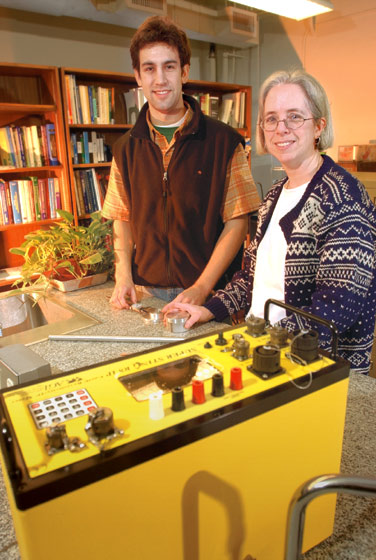Sinkholes caused by dissolving limestone can collapse with disastrous results. Adam Faroni ’04 (Granby, Conn.) and Sandra Henning ’05 (Jarrettsville, Md.) are helping prevent such catastrophes by assessing a cavern on Lafayette’s campus.
Henning and Faroni are working as EXCEL Scholars with Mary Roth, associate professor of civil and environmental engineering. In EXCEL, students work closely with faculty on research while earning a stipend.
Roth received a $76,749 grant from the National Science Foundation for research on improving methods of investigating sites located in sinkhole areas. Through a Fulbright Grant, she pursued research last year in multi-electrode earth resitivity testing in Oslo, Norway, with the Norwegian Geotechnical Institute. Through her work as a geotechnical engineer, she designs foundations, dams, and tunnels. She has provided private consulting services for a number of years, including work in dam rehabilitation
The research team is examining a cave located below Lafayette’s Metzgar Field and plan to determine the cavern’s dimensions using lasers, a digital camera, and multi-electrode earth resistivity testing, which measures the electrical contrasts between different geological materials.
The cave, detected as an anomaly in a ground surveillance test, was formed as rainwater and underground water flow dissolved limestone deposits. Such caves are common and resulting voids may cause land to collapse.
Henning, a civil engineering major, is studying the sinkhole formation process and the principles of using resistivity as a site investigation tool. She is also helping Roth conduct initial calculations to determine the usefulness of an alternative measurement technique.
A mechanical engineering major, Faroni is designing the mechanical equipment that will be used to measure the cave’s dimensions, including laser devices that consist of a tripod on the ground surface attached to a “rotateable” shaft with a retracting laser on the bottom.
Because the cave has no entrance, the measurement devices must fit down two separate holes drilled into the cave. The researchers have designed a setup with two lasers and one camera that will be sent down the holes. The two lasers will rotate to shine beams at the same point on the wall. The camera will be used to determine the location of the beams, and measure the resulting angles between the two devices to determine the distance to the wall of the cave.
“The biggest obstacle we face is the functionality of the retracting end of the laser,” Faroni says. “We will be trying different setups in the coming weeks so that the retracting laser will be 100 percent effective. I have really enjoyed this project because it has allowed me to use creativity to design a useful tool that may lead to a new method for determining cave volumes.”
Faroni says the plan is to do a 360-degree sweep of the cave in ascending planes, working from the bottom to the top. By measuring the distance between each level, they will be able to calculate the volume of the cave.
“So far, the project is going well,” says Henning. “I’m developing a simple formula to compute the distance between the digital camera and photographed objects using the pixel differences. In addition, I have been learning about the geographic region were Lafayette is located.”
Henning describes Roth as “a great adviser” with an amazing knowledge of the subject and a strong desire to share it.
Faroni says Roth presented him with a golden opportunity by suggesting that he design two laser devices to measure the volume of the cave, and explains that she has been very helpful, offering valuable insight into ways of overcoming the project’s obstacles.
“The small class sizes, in combination with Lafayette’s engineering resources, have been a major plus,” he says. “I find the students are supportive of one another and willing to take time to help fellow classmates.”
“The project is still in its initial phase, and both students are making excellent progress in their respective areas,” Roth says. “I hope they will both gain experience in developing a research approach to an engineering problem and next summer implement that approach in a real situation.”
Roth is encouraging the students to publish the results of their work and present the paper at a professional conference.

Mechanical engineering major Adam Faroni ’04 is doing EXCEL Scholars research with Mary Roth, associate professor of civil and environmental engineering, that may help prevent the disastrous effects of collapsing sinkholes.
